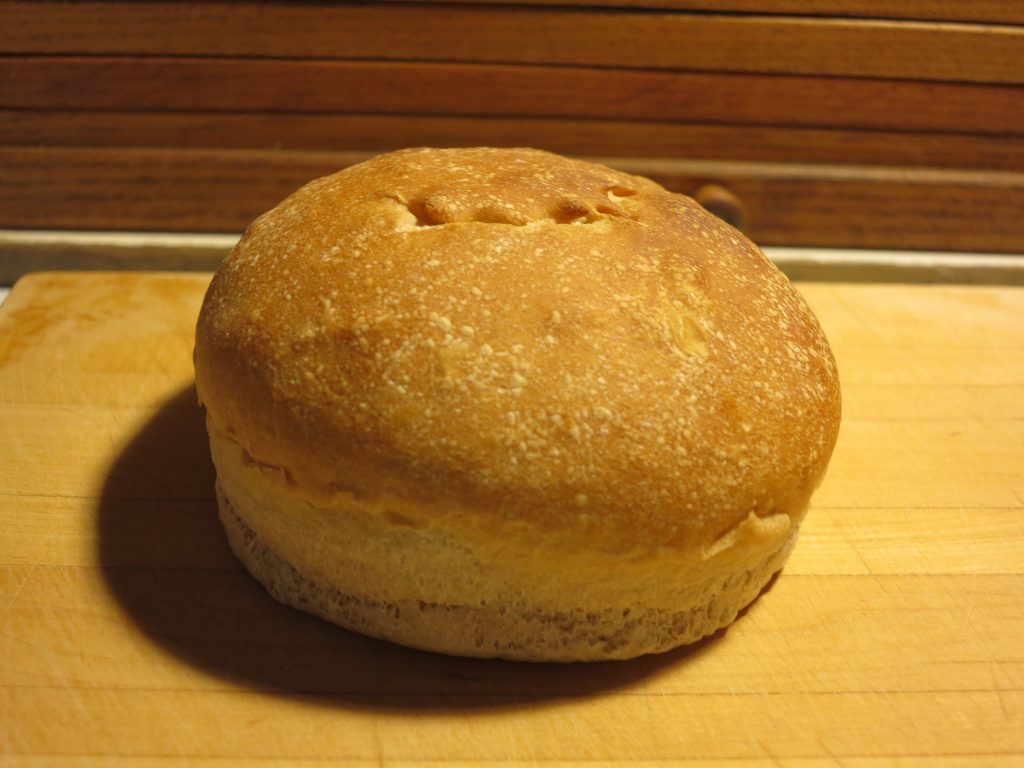
Bread, adapted from Mary Randolph’s 1824 recipe
To Make Bread
Mary Randolph, The Virginia House-Wife (1824)
When you find the barrel of flour a good one, empty it into a chest or box made for the purpose, with a lid that will shut close; it keeps much better in this manner than when packed in a barrel, and even improves by lying lightly; sift the quantity you intend to make up, put into a bowl three quarters of a pint of cold water to each quart of flour, with a large spoonful of yeast, and a little salt, to every quart; stir into it just as much of the flour as will make a thin batter, put half the remaining flour in the bottom of a tin kettle, pour the batter on it, and cover it with the other half; stop it close, and set it where it can have a moderate degree of warmth. When it has risen well, turn it into a bowl, work in the dry flour and knead it some minutes, return it into the kettle, stop it, and give it moderate heat. In the morning, work it a little, make it into rolls, and bake it. In the winter, make the bread up at three o’clock, and it will be ready to work before bed time. In summer, make it up at five o’clock. A quart of flour should weigh just one pound and a quarter.
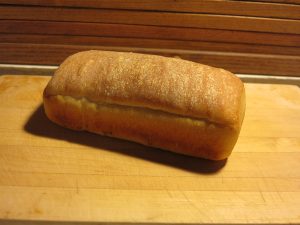
Randolph’s Bread Baked in a Loaf Pan
Bread as Mary Randolph Made It
Weigh 20 ounces of low-protein all-purpose flour* (such as Gold Medal or Pillsbury brands) or measure 4 cups of flour by dipping a 1-cup dry measure into a settled container of flour and sweeping off the excess with a knife. Turn the flour into a 3- to 4-quart bowl, add 1 1/2 teaspoons fine-textured salt, and whisk to blend.
In a small bowl, whisk together 1 1/2 cups cold water and 1/4 teaspoon granulated dry yeast and let the mixture stand for a minute or two to let the yeast dissolve. Add 1 cup of the flour/salt mixture and whisk to make a smooth batter.
Remove and set aside a generous cupful of the flour/salt mixture in the bowl. Make a deep well in the flour that remains in the bowl and pour the yeasted batter into it. Sprinkle the flour you set aside evenly over the batter, completely covering it. Set the bowl aside until the sponge puffs up and begins to crack through the flour on top, about 3 hours.
Using a large rubber spatula, gradually incorporate the dry flour in the bowl into the sponge. (If you do this carefully, you won’t have to wash and dry the bowl in preparation for proofing the dough.) When the dough becomes too stiff to manipulate with the spatula, pick up the dough with your hand and blot up the last of the flour. Cover the bowl with plastic wrap or a plate and let the dough stand for 10 minutes so that the flour can absorb the water, making the dough easier to handle.
Turn the dough out onto work surface and begin to knead it. At first it will be quite sticky, so knead it lightly until it begins to detach from your hands. (Resist the temptation to flour the dough. Washing and drying your hands helps.) As soon as you can, begin to knead the dough more forcefully and keep at it until the dough is smooth and putty-like and feels resistant when you press down on it. Allow a good fifteen minutes of kneading altogether. If the dough is under-kneaded, the baked bread will be heavy and sticky and have a grayish cast—instead of being “white and light,” as Catharine Beecher says it should be. (Of course, the kneading can be dispatched in a stand mixer fitted with a dough hook. I haven’t tried this, but my guess is that machine will do the job in about 10 minutes.)
If necessary, wash and dry the mixing bowl. Form the dough into a neat ball, place it in the bowl, and cover with a plate or plastic wrap. Let the dough proof until it has tripled in volume and retains a shallow dent when lightly pressed with your forefinger. This will take 4 to 5 hours depending on the heat of the room.
Scrape the dough out of the bowl onto your work surface and fold it a few times to deflate it. Divide the dough in half. (Each half will weigh almost exactly 1 pound.) If you wish to bake your loaves in pans, have ready two generously buttered medium-size loaf pans with a capacity of 6 cups. For hand-shaped loaves, have ready a large baking sheet covered with parchment paper.
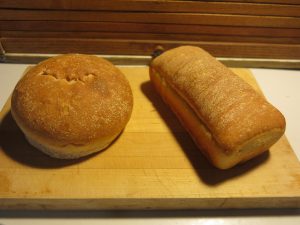
Hand-shaped and Pan-baked Loaves
To form a pan-baked loaf, pat the dough out into a 6- X 4-inch rectangle (approximately) and press a trench down the length of the dough with the side of your hand. Fold one of the long sides of dough rectangle in, so that its edge meets the trench, and press the doubled dough to seal. Fold the doubled dough to meet the opposite edge of the rectangle and press again to seal. Transfer the dough, seam side down, to the buttered pan. When both loaves are formed, drape plastic wrap over the pans.
To form a hand-shaped round loaf, pat the dough into a round 4 to 5 inches in diameter, fold the round in quarters, and press to seal. Pick the dough up in your hands and shape it into a ball by tugging the folds into the bottom of the loaf, where a dimple (or so Julia Child describes it) will form. Place the loaf to one side of the baking sheet, leaving room for the other. When both loaves are formed, drape a sheet of well-floured plastic wrap over them.
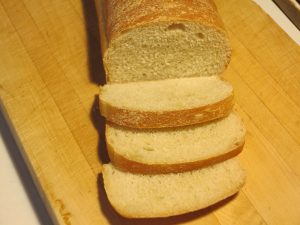
Sliced Loaf
Let the loaves rise until they have slightly more than doubled, about 1 1/2 hours. Remove the plastic wrap. Bake the loaves in the upper-middle level of a 400⁰ oven until they sound hollow when tapped on the bottom—or, more reliably, until an instant-read thermometer, inserted from the bottom into the center of the loaf, registers between 205⁰ and 210⁰. This will take about 30 minutes. Remove the loaves from the pans or sheet, place on racks, and let cool completely. While best if eaten within 24 hours, this bread will remain reasonably fresh for three or four days if wrapped tightly in plastic.
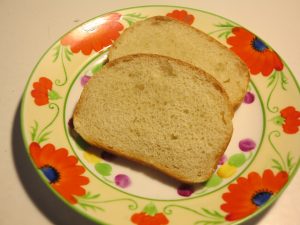
Slices Showing Small, Tight Crumb
*Low-protein all-purpose flour contains approximately 3 grams of protein per 30 grams of flour. This information will be indicated on the package.
